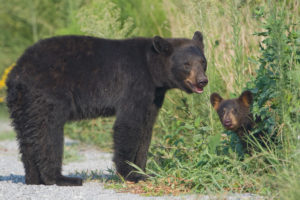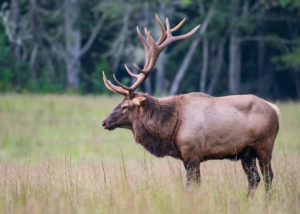July 27, 2020
Elk in the Great Smoky Mountains
Have you seen elk in the Great Smoky Mountains National Park? Our area is home to nearly 200 of the magnificent animals.
Elks are awe-inspiring creatures. The males can weigh up to 700 pounds. The females fiercely defend their offspring and may charge challengers. For a few weeks during the fall mating season, the males, with fully developed racks, bugle and fight to get the attention of the females. The females gather in groups, called harems, on the edge of the fighting fields.
Large herds of elk once roamed along the Appalachian Mountain Range from George to Canada. But, due to overhunting and habitat destruction, the species disappeared from the region in the 1800’s. The National Park Service determined it was appropriate to bring back a native species that had been eliminated from park lands. A small herd of 25 of the animals was reintroduced to the park in 2001. As part of the experiment, the animals were outfitted with radio collars. In 2002 another 27 animals were brought to the area. This reintroduction has been very successful and today the population flourishes.
Best Places to View Elk
The elks have become celebrities, attracting many visitors each year. Most of the elk can be found in the Cataloochee area in the southeastern area of the park. They may be active on cloudy summer days and before or after storms. But the best time to spot them is early morning or late evening. The Park Service reminds you to enjoy the animals from a distance and use binoculars for close-up views. In fact, approaching within 150 feet, or any distance that disturbs the animals, is illegal in the park. To avoid fines and arrest, do not enter the field. Remain by the roadside, please. http://www.nps.gov
Please send your pictures to [email protected]. We would love to share them with other guests!
July 9, 2018
Black Bears in the Smokies
The Great Smoky Mountains National Park is a large, protected area where black bears can roam freely. The park service estimates that about 1,500 bears live in the park–that translates to a density of about two of the animals per square mile. Sighting one of these magnificent creatures is a highlight of a vacation, but caution is necessary for the protection of the bear and of the tourist. Bears can live 12-15 years or more in the wild, but those which have had access to human food and garbage have a life expectancy of only half that time.

Black bear (Ursus americanus) mother standing in the road with young cub peeking out from the bushes.
Behavior of Bears
Like us, bears are omnivores. Berries and nuts make up about 85% of their diet. Insects and carrion are valuable sources of protein. These creatures have a very keen sense of smell. Feeding bears, or allowing them access to human food and garbage causes a number of problems. It causes them to lose their instinctive fear of humans. Over time this means they may begin approaching people and may become more unpredictable and dangerous. They may begin to pose a risk to public safety and must be euthanized. In other cases they come close to human areas and are hit by cars or become easy targets for poachers. The park service warns us that Garbage Kills Bears!
What Do I Do If I See Bears?
They are beautiful creatures. But remember that they have color vision, a keen sense of smell, are good swimmers and tree climbers, and can run 30 miles per hour. The park service provides a short video to help tourists understand what to do if they see a bear http://www.nps.gov/grsm/learn/nature/black-bears.htm If you do see a bear you should remain watchful and not approach it. Do not allow the bear to approach you. Being too close may promote aggressive behavior from the bear. For these reasons, willfully approaching within 50 yards (150 feet) or any distance that disturbs or displaces a bear, is illegal in the park. Use binoculars or a telephoto lens to view them.
If the bear approaches you, don’t run but rather back slowly away. The bear will probably do the same. If he continues to approach you, change your direction. If he continues, stand your ground and talk loudly or shout at it. Make yourself look as large as possible. Use a stout stick to intimidate the bear. It is very rare that you would be physically attacked, but if so you should not play dead. Fight back aggressively with any available object.
Remember, the goal of bear management is to keep these magnificent animals shy, secretive, and afraid of people.





Gatlinburg Weather
Click for weather forecast